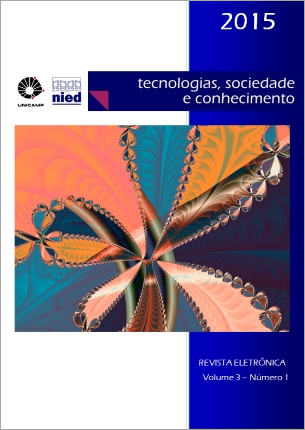Resumo
Pesquisas recentes têm explorado o uso de tecnologias computacionais de interação tangível no tratamento de crianças com autismo. Ao mesmo tempo, as tecnologias que promovem este tipo de interação são geralmente configurações complexas de dispositivos físicos, o que representa uma barreira para sua ampla utilização. Esta pesquisa investiga o uso de Tablets para se criar um sistema com interface tangível móvel que supere esta barreira.
Referências
ALESSANDRINI, A.; CAPPELLETTI, A.; ZANCANARO, M. Audio-augmented paper for therapy and educational intervention for children with autistic spectrum disorder. International Journal of Human-Computer Studies, 2014.
BIANCHI, A.; OAKLEY, I. Designing Tangible Magnetic Appcessories. International Conference on Tangible, Embedded and Embodied Interaction, 2013.
ESCOBEDO, L.; IBARRA, C.; HERNANDEZ, J.; ALVELAIS, M.; TENTORI, M. Smart objects to support the discrimination training of children with autism. Personal and Ubiquitous Computing, vol. 17, n. 8, p. 1485-1497, 2013.
FARR, W.; YUILL, N.; HARRIS, E.; HINSKE, S. In My Own Words: Configuration of Tangibles, Object Interaction and Children with Autism. International Conference on Interaction Design and Children, 2010a.
FARR, W.; YUILL, N.; RAFFLE, H. Social benefits of a tangible user interface for children with Autistic Spectrum Conditions. Autism: the international journal of research and practice, XIV, 2010b.
ISHII, H. Tangible Bits: Beyond Pixels. Anais, Tangible and Embedded Interaction, 2008.
KETABDAR, H.; YÜKSEL, K. A.; ROSHANDEL, M. MagiTact: Interaction with Mobile Devices Based on Compass (Magnetic) Sensor. International Conference on Intelligent User Interfaces, 2010.
MARCO, J.; CEREZO, E.; BALDASSARRI, S. Bringing tabletop technology to all: evaluating a tangible farm game with kindergarten and special needs children. Personal and Ubiquitous Computing, Vol. 17, n. 8, 2013.
MOHER, D; LIBERATI, A; TETZLAFF, J.; ALTMAN,D.G. Preferred Reporting Items for Systematic Reviews and Meta-Analyses: The PRISMA Statement. PLoS Medicine,Vol. 6, n. 7, 2009.
SITDHISANGUAN, K.; CHOTIKAKAMTHORN, N.; DECHABOON, A.; OUT, P. Evaluation the Efficacy of Computer -Based Training Using Tangible User Interface for Low-Function Children with Autism. Second IEEE International Conference on Digital Game and Intelligent Toy Enhanced Learning, 2008.
SITDHISANGUAN, K.; CHOTIKAKAMTHORN, N.; DECHABOON, A.; OUT, P. Using tangible user interfaces in computer-based training systems for low-functioning autistic children. Springer-Verlag London Limited, 3 Maio 2011. 143-155.
VARELLA, D. Dr. Drauzio Varella. Site do Dr. Drauzio Varella, 19 abr. 2011. Disponivel em: http://drauziovarella.com.br/crianca-2/autismo/. Acesso em: 21 mar. 2016.
VILLAFUERTE, L.; JORDÀ, S.; MARKOVA, M. S. Acquisition of Social Abilities Through Musical Tangible User Interface: Childrenwith Autism Spectrum Condition and the Reactable. Conference on Human Factors in Computing Systems (CHI), 2012.
WESTEYN, T. L.; ABOWD, G. D.; STARNER, T. E.; JOHNSON, J. M.; PRESTI, P. W.; WEAVER, K. A. Monitoring children’s developmental progress using augmented toys and activity recognition. Personal and Ubiquitous Computing, Vol.16, n. 2, 2012.
YU,N.-H.; CHAN, L.-W.; LAU, S.-Y.; TSAI, S.-S.; HSIAO, I-C.; TSAI, D.-J.; CHENG, L.-P.; HSIAO, F.-I; CHEN, M. Y.; HUANG, P.; HUNG, Y.-P. TUIC: Enabling Tangible Interaction on Capacitive Multi-touch Display. Conference on Human Factors in Computing Systems (CHI), 2011.

Este trabalho está licenciado sob uma licença Creative Commons Attribution 4.0 International License.
Copyright (c) 2016 Tecnologias, Sociedade e Conhecimento


